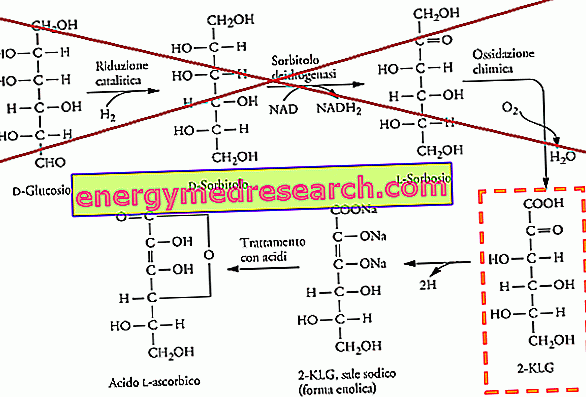Generality
Peaches are the fruits of peach ( Prunus persica L. Batsch.), A tree plant closely related to other fruit trees in Italy, such as those that produce: plums, apricots, cherries, sour cherries, almonds, etc.

From the botanical point of view, peaches are "real fruits" that belong to the "simple" group; in particular, it is morphologically organized fleshy fruits like drupes. Peaches are wrapped in an exocarp (peel) that can be smooth or with hair, red or yellow or white, or totally yellow. The intermediate portion (mesocarp) is fleshy, white, yellow or red, and has a different consistency depending on the variety ( NB . Exocarp and mesocarp are the two edible portions of the fruit). The "heart" (which we all call the seed) is called an endocarp; it has a woody consistency, an irregular surface and contains a single seed (true fruit).

Nutritional Features
Peaches are foods that belong to the VI food group. They are sweet and provide a typically moderate energy intake. Calories are essentially supplied by fructose, while proteins and lipids are almost marginal.
Peaches do not negatively affect cholesterolemia, as they lack cholesterol and significant amounts of saturated fat. However, it is a food potentially subject to abuse in the summer season, as it is sweet and refreshing because it is rich in liquids. However, a medium-sized fishing weighs about 150-200g and consuming them in freedom can have undesirable repercussions on blood sugar, triglyceridemia and body weight.
Peaches contain a good dose of fiber, as long as they are consumed with the skin; in the absence of the latter, the quantity is halved.
The vitamin portion of the peaches is discreet and mainly affects the provitamins A or retinol equivalent. At the same time, the salt profile benefits from an excellent concentration of potassium.
Nutritional tables
Composition for: 100g of Peaches - Reference values of the INRAN Food Composition Tables
| Peaches, without peel | Peaches, with peel | ||||
 | |||||
| Edible part | 91% | -% | |||
| water | 90.7g | - g | |||
| Protein | 0.8g | 0.7g | |||
| Prevailing amino acids | - | - | |||
| Limiting amino acid | - | - | |||
| Lipids TOT | 0.1g | tr | |||
| Saturated fatty acids | 0.0g | 0.0g | |||
| Monounsaturated fatty acids | 0.0g | 0.0g | |||
| Polyunsaturated fatty acids | 0.0g | 0.0g | |||
| Cholesterol | 0.0mg | 0.0mg | |||
| TOT Carbohydrates | 6.1g | 5.8g | |||
| Starch | 0.0g | 0.0g | |||
| Soluble sugars | 6.1g | 5.8g | |||
| Ethyl alcohol | 0.0g | 0.0g | |||
| Dietary fiber | 1.6g | 1.9g | |||
| Soluble fiber | 0.87g | 0.78g | |||
| Insoluble fiber | 0.71g | 1.14g | |||
| Power | 27.0kcal | 25.0kcal | |||
| Sodium | 3.0mg | - mg | |||
| Potassium | 260.0mg | - mg | |||
| Iron | 0.4mg | - mg | |||
| Football | 8.0mg | - mg | |||
| Phosphorus | 20.0mg | - mg | |||
| Thiamine | 0.01mg | - mg | |||
| Riboflavin | 0.03mg | - mg | |||
| Niacin | 0.5mg | - mg | |||
| Vitamin A | 27.0μg | - µg | |||
| C vitamin | 4.0mg | - mg | |||
| Vitamin E | - mg | - mg | |||
Variety of peaches and signs of use
The criteria that differentiate the various types of peaches are: skin color, presence or absence of external hair, color and texture of the dough and its adherence to the stone. The most well-known are: Yellow peach (yellow, with hair and free hazel), white peach (white pulp, without hair, with hazelnut attached), nectarine or walnut peach (yellow or white pulp, smooth red skin, free stone) or attached), percoco (fishing used for industrial processing in juices, jams, fruit in syrup etc.), merendella (smooth and white skin, hazelnut attached), peach saturnine (typically flattened), peach montagnola (white flesh and peel provided with down).
Obviously, not all peaches lend themselves equally to the same processes. Each peach can be eaten raw, but some are more suitable for processing such as: jam, dried fruit, canned fruit, fruit juices and as an ingredient in other preparations such as yogurt.
Peaches in Syrup - Recipe to Prepare them in Safety
X Problems with video playback? Reload from YouTube Go to Video Page Go to Video Recipes Section Watch the video on youtubePeach Tree
The peach tree is of Chinese origin. From the land of origin it was imported into Persia and, through the trade routes, into Europe. From here, the colonial ramifications of the Roman Empire allowed its dissemination throughout the Mediterranean.
The peach tree is medium-sized; reaches 8 meters in height and shows a rather superficial root system. The bark is brown-ash-colored; the branches are sparse, red-brown in color. The peach leaves are lanceolate, narrow and with a serrated edge. The flowers bloom before the leaves and are hermaphroditic, light or dark pink, provided with five petals and numerous stamens.



